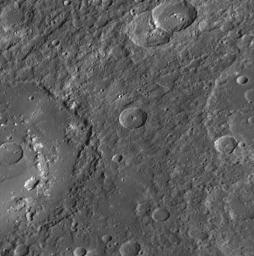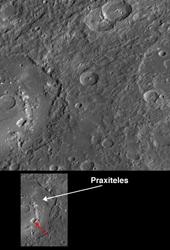
|
A Peek into Praxiteles
- Click the image above for a larger view
- Full-Res JPEG (1018 x 1024) (150.7 kB)
- Full-Res TIFF (1018 x 1024) (1.0 MB)
Caption:

Click on the image
for larger version
The large crater extending out the left side of this image is Praxiteles. Named for the ancient Greek sculptor of the 4th century BC, Praxiteles crater was first observed by Mariner 10. MESSENGER's high-resolution NAC images (one of which is shown here) and 11-color Wide Angle Camera (WAC) images have provided a detailed new look at this crater. Of particular interest are irregularly shaped depressions on the crater's floor, the largest of which is indicated by the red arrow and located just inward of the crater's peak ring. The colors near these depressions in WAC images are similar to those near volcanoes discovered during the mission's first Mercury flyby (see PIA11013 ) along the inner edge of the Caloris basin ( PIA10359 ). The similar colors and the association with the irregular depressions (possible volcanic vents) are suggestive of past volcanic activity on the floor of Praxiteles.
Date Acquired:
October 6, 2008
Image Mission Elapsed Time (MET):
131771678
Instrument:
Narrow Angle Camera (NAC) of the Mercury Dual Imaging System (MDIS)
Resolution:
220 meters/pixel (0.14 kilometers/pixel)
Scale:
Praxiteles crater has a diameter of 182 kilometers (113 miles)
Spacecraft Altitude:
8,500 kilometers (5,300 miles)
Background Info:
These images are from MESSENGER, a NASA Discovery mission to conduct the first orbital study of the innermost planet, Mercury. For information regarding the use of images, see the MESSENGER image use policy .
Cataloging Keywords:
| Name | Value | Additional Values |
|---|---|---|
| Target | Mercury | |
| System | ||
| Target Type | Planet | |
| Mission | MESSENGER | Mariner |
| Instrument Host | MESSENGER | Mariner 10 |
| Host Type | Orbiter | Flyby Spacecraft |
| Instrument | Mercury Dual Imaging System (MDIS) | |
| Detector | Narrow Angle Camera (NAC), Wide Angle Camera (WAC) | |
| Extra Keywords | Crater, Grayscale, Volcano | |
| Acquisition Date | ||
| Release Date | 2009-03-17 | |
| Date in Caption | 2008-10-06 | |
| Image Credit | NASA/Johns Hopkins University Applied Physics Laboratory/Carnegie Institution of Washington | |
| Source | photojournal.jpl.nasa.gov/catalog/PIA12040 | |
| Identifier | PIA12040 | |
